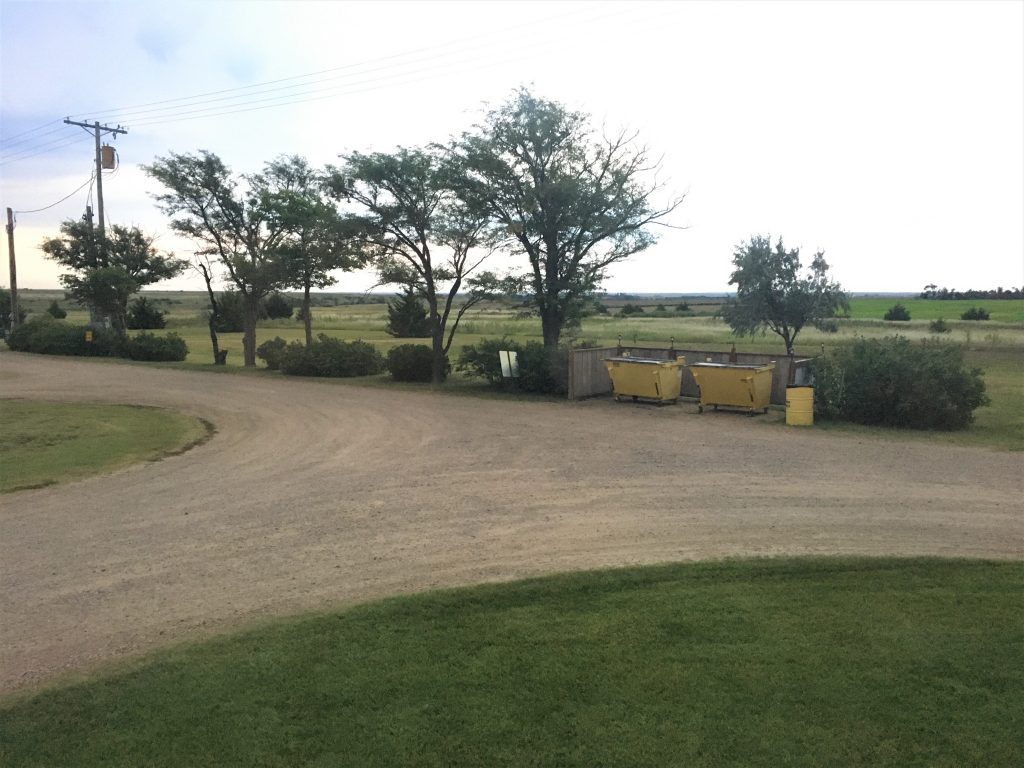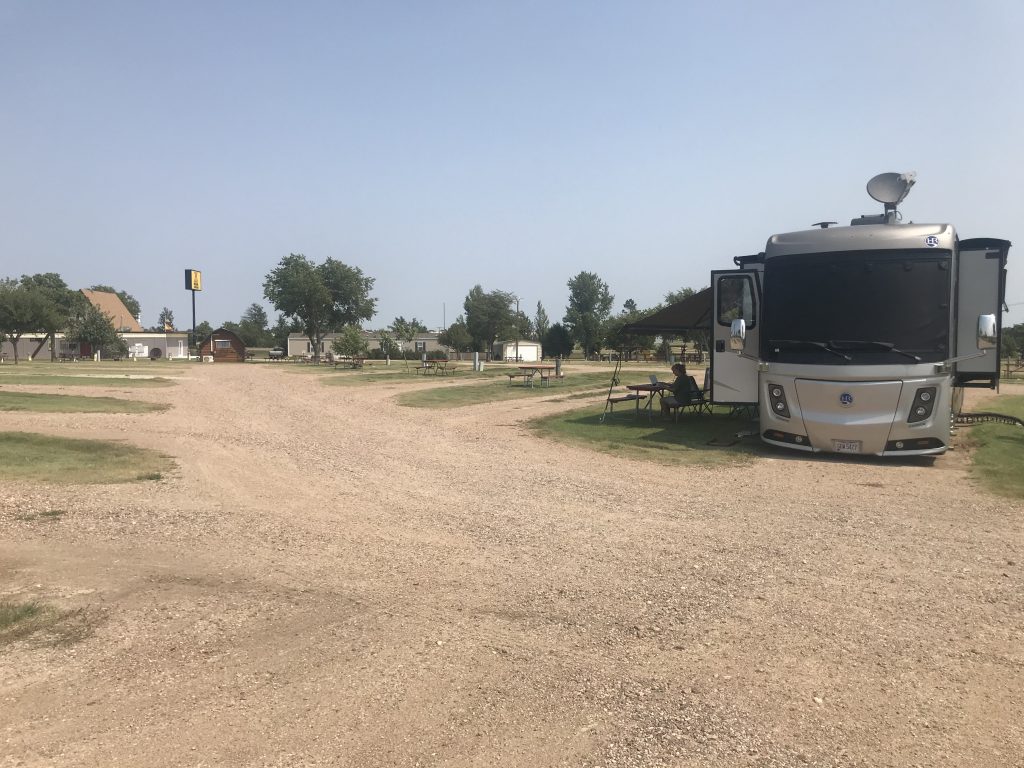Wakeeney KOA, Wakeeney, Kansas
If a ruler listens to lies, all his officials become wicked. ~ Proverbs 29:12

You know things must be pretty doggone bad when you’re been away from home for nine months and the person you’re most looking forward to seeing is your hairdresser. Yes. It’s that bad. I can’t remember if I’ve mentioned it before, but the last time I had a haircut and proper color was in early November when we were in Alabama. It was supposed to be done again around January or February, but then COVID hit. And then, I figured I might as well wait until I got home to get a proper Helix cut. I just gotta hold out for 24 more days . . .

There’s no one here!!
But it filled up to nearly bursting late afternoon and evening!
Blaine chose this new location for its convenience and because there’s quite literally nothing to do here. This gives us four nights and three days to get a few things done, before we move on toward home. So, since I have nothing else much to share today, how about a lesson on Kansas agriculture? Don’t worry. I’ll keep it short. 😊
What do you think of when you think of Kansas? Movies with green witches and little dogs? How about in the agriculture department?
When I was ten years old, my maternal grandmother took me on a Greyhound bus tour across the country from Ohio, where we lived, to the coast of Oregon, where her son/my uncle lived at the time. I remember several things about that bus ride. It took us three days and three nights. I don’t remember where we slept, but I could guess it was on that bus. I remember we stopped for meals and potty breaks. I remember one bus driver (they swapped them out every so often) played the harmonica softly during the dark hours. I remember another driver telling corny jokes like, “Everybody, lift your feet!” And we all did! Because back then people were more fun. But the reason we lifted them was, “We’re crossing over the Snake River and I didn’t want you to get your feet wet!” 😊 And I remember sleeping through most of Kansas, because it was nothing but driving through giant stalks of corn that lined the road, for what seemed like a million miles, and you couldn’t see anything else.
I don’t know what road we were on, but the roads we’ve been on are nothing like that. Everything is wide open space. And outside of that small patch we saw when we drove in, we’ve not seen another stalk of corn. We’ve seen cows, and sunflower farms (unfortunately they’re all facing east, the same direction we travel in), and lots of windmill farms, and something else we couldn’t identify until I found it today – sorghum.
So, Kansas agriculture. Here’s what I found out from the Kansas State Historical Society – – –
90% of the land area of Kansas is devoted to agriculture production! Ninety-percent!! What in the world would we do without Kansas?!? We’d all starve! Wheat takes first place, followed by corn, soybeans, grain sorghum (what’s that??) and hay. And Kansas leads the nation in the production of both wheat and grain sorghum. Sounds like I’d best be finding out what sorghum is!
Turns out sorghum has many uses – from biofuel, to animal fodder and forage, to building materials, brooms and brushes (that’s what the stalks and fibers are used for), in addition to its sugar content.
It seems sorghum also has a ton of health benefits! Here’s what I discovered on americansorghum.com:
1. High Nutritional Value
Sorghum has a whopping 22 grams of protein in a 1 cup (192 gram) serving of the cooked, whole grain. A woman’s daily recommended protein intake is 46 grams and a man’s is 56 grams. On average, that means sorghum contains 43 percent of your daily protein intake.
One serving also contains 47 percent of your daily recommended iron and 55 percent of your phosphorus intake. It’s also a good source of magnesium, copper, calcium, zinc and potassium.
A serving of sorghum also contains around 30 percent of your recommended intake of both niacin and thiamin. These two B-vitamins help us to metabolize and properly absorb carbohydrates and nutrients.
2. Rich in Antioxidants
Sorghum contains a wide variety of beneficial phytochemicals that act as antioxidants in the body, such as tannins, phenolic acids, anthocyanins, phytosterols and policosanols.
In fact, the bran layer of sorghum has significantly higher amounts of antioxidants than fruits such as blueberries, strawberries and plums.
Antioxidants help to slow down aging, and antioxidant-rich foods have been linked to a lower risk of heart disease, cancer, type II diabetes and some neurological diseases.
Many studies indicate that whole grain consumption significantly lowers mortality from cardiovascular disease, and antioxidant phytochemicals are believed to be the main reason. They have been shown to reduce blood cholesterol and prevent arterial clotting.
3. Improves Digestive Health
Sorghum is one of the best sources available for dietary fiber. One serving contains 48 percent of your daily recommended intake of fiber.
Fiber is vital for overall digestive function. It keeps your digestive tract moving and of course prevents constipation. But it also helps to regulate blood sugar, lower cholesterol, and prevent diverticulitis, hemorrhoids, gallstones and kidney stones.
4. Inhibits Cancer
Certain phytochemicals in sorghum have also been shown to have cancer-inhibiting properties, particularly in gastrointestinal and skin cancers.
Studies have shown that sorghum consumption is linked to lower incidences of esophageal cancer globally, including parts of Africa, Russia, India, China and Iran. Wheat and corn consumption have been linked to elevated rates of esophageal cancer.
Whole grains in general are correlated with reduced risks of other forms of digestive tract cancer, especially colon cancer. It is unknown if this is due to the phytochemicals or dietary fiber in grains, but as sorghum is high in both, it would certainly provide the same benefits as other grains.
5. Gluten-Free
Sorghum is safe to eat for those with Celiac disease. The Journal of Agricultural and Food Chemistry published a study that analyzed the genome of sorghum to determine if it contained any gluten proteins. They confirmed that gluten is absent in all varieties of sorghum.
6. Currently Non-Genetically Modified
Another benefit of sorghum is that it’s a non-genetically modified crop.
Although, the company DuPont Pioneer is working to develop a genetically modified (GM) variety.
Most plant genetic engineering to date has been to improve a crop’s herbicide tolerance and resistance to pests. DuPont is working on a new type of genetic engineering to enhance the micronutrient content of sorghum. Their goal is to develop a “biofortified” strain of sorghum with higher vitamin A, more easily absorbed iron and zinc, and an improved balance of amino acids. They have already grown trial GM sorghum crops in Africa.
GM sorghum is not grown in North America yet, but always buy certified organic sorghum products when you can find them. This will ensure there is no GM material present, as well as avoiding harmful pesticide residues.
7. Many Uses
Sorghum is a very versatile grain. It is best eaten in its whole grain form to get the most nutrition. It can be prepared similar to rice.
Try soaking whole sorghum for 8 hours or overnight to first break down the enzymes and make it more digestible. Then boil it in three times as much water for about an hour or until tender. It can also be cooked in a rice steamer or slow cooker.
Sorghum flour is becoming a popular gluten-free substitute for wheat flour in baked goods. Make sure you buy the whole grain form of sorghum flour, which is simply the whole grains ground into flour. Refined sorghum flour is also available, but like most refined products, the nutrient content is reduced.
In some countries, sorghum is eaten as porridge or boiled directly into various dishes. The Ethiopian bread injera can be made from sorghum, as well as many gluten-free beers and even biofuels.
As its popularity rises, sorghum is becoming much more common in grocery stores and markets. It’s definitely a grain that deserves a place at our tables.

Upon closer inspection, we quickly realized it didn’t look quite right.
And that’s all you get for today! An opportunity to expand your mind!
